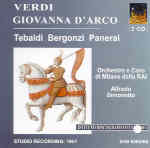Verdi’s Joan of Arc is a product of his galley years. A flop at its La Scala premiere in 1845, it hasn’t fared well since despite its compact, swift-moving narrative and good opportunities for three leads. The libretto by Solera from a Schiller play has a lot to do with its failure to ignite enthusiasm. No burning at the stake here. Instead, Joan and Charles VII are in love and Joan’s dad, convinced she’s become prey to the Devil, interrupts her coronation procession to denounce her and convinces her to save her soul by going to the stake as a witch. Overhearing Joan’s prison prayer convinces him she’s kosher after all, so Dad liberates her from jail and Joan rushes off to win another great battle against the English, albeit at the cost of her life. The opera’s end has Joan rising from her bier and, French flag in hand, ascends to heaven. This is the kind of nonsense that gives opera a bad name. Gounod or Massenet might have been able to bring it off, but the early Verdi, try as he might, couldn’t. To add to his problems, there are two dream arias, one apiece for Charles and Joan, almost back-to-back.
Some of the music is of the oom-pah variety, but there’s some lovely wind-based scene painting in the orchestra and the arias are fine examples of early Verdi, including Joan’s “O fantidica foresta”, sung here with limpid beauty by the young Renata Tebaldi, and the following duet with her Carlo, Carlo Bergonzi. They’re the reasons to hear this 1951 RAI performance of the opera, especially since there are few examples of these singers’ early careers available on CD. From their very first notes you know you’re listening to major league talents bound for glory.
What is surprising though, is that Bergonzi at age 27, just three years after his stage debut as a baritone and in his first year as a tenor, already is an accomplished Verdian stylist. Just listen to his entrance aria, “Sotto una quercia”, with its ravishing diminuendo from a ringing forte and stylish singing that makes every note breathe. His every phrase is suffused with the sensitivity to musical line and text that so distinguished his later career.
To single out Bergonzi and Tebaldi (who sings here with the fiery conviction not always displayed in her later studio recordings) as the reasons for this release is not to disparage the significant part Rolando Panerai plays in the success of this performance. His is a true Verdian baritone voice, fast becoming a rarity these days, and he’s convincing both as the stern and the remorseful father of Joan. Alfredo Simonetto leads a tightly sprung performance that would be a lot better if his orchestra didn’t sound like the provincial band it was in those rough early post-war years.
IDI’s sound is quite listenable, and although the singers come through clearly, the halo of aural fuzz around the voices indicates runaway filtering or other digital processing artifacts. It’s annoying but it doesn’t really get in the way to an unacceptable degree. The preferred Giovanna D’Arco is, and probably always will be, the stereo EMI set with James Levine conducting Caballé, Domingo, and Milnes. But admirers of Tebaldi and Bergonzi must have this one.
































